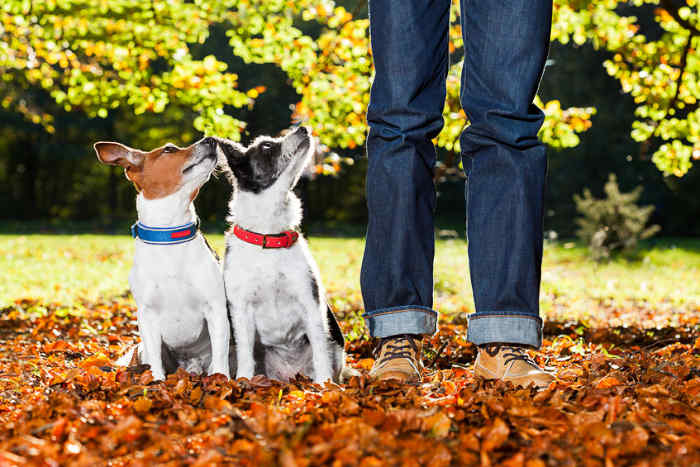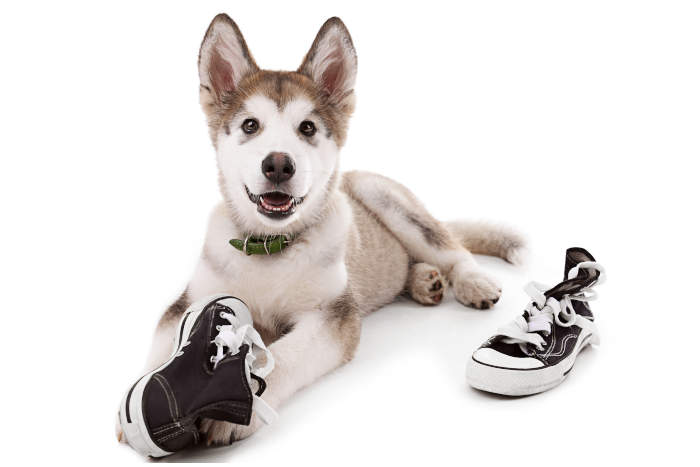While barking is a completely normal way in which dogs express themselves, as well as convey their emotions to other dogs and humans; excessive, undesirable barking is a common problem many owners experience with their canine pals.
It doesn’t take much for some dogs to get over-excited or extremely worked up – the smallest of things can trigger them into a painfully long and loud frenzy. It may be the postman dropping off the mail, another dog, or even a slight disturbance from the neighbor three doors down.
We’ll go through five common situations leading to excessive barking and give you the guidance needed to deal with this frustrating behavior. Keep in mind, aiming to completely stop your dog from barking is not realistic, nor is it possible. Dogs will bark, it’s in their nature. What you can do is reduce the amount of barking that goes on, and bring it to an acceptable level. Meaning, your dog can still express himself, you’ll have more control over his barking tendencies – and you, your visitors and your neighbors can enjoy more peace and quiet.
Barking at Home
Use The Speak and Shush Method
Since we’ll be training your dog to “speak” first (aka: bark), this method may seem counter-intuitive. But once you’ve got your dog to speak on cue, you can easily gain control over getting him to “shush” at your convenience. For this method you’ll need a training buddy whose job is to stand at your front door, waiting for your signal to ring the door bell (or knock). This method can also be easily modified for use in other situations, such as your phone ringing, or someone walking past your window. Here’s what you do:
Step 1: You’ll need to enlist an accomplice to stand outside your front door while you and your dog are inside. Your assistant must be able to hear you.
Step 2: Command your dog to “speak,” which subsequently is your assistant’s cue to ring the bell. Make sure your assistant rings the bell a couple of seconds after your command.
Step 3: The door bell should prompt your dog to start barking, at which point you’ll want to praise your dog profusely.
Step 4: After a good few barks, softly but firmly say “shush” and swiftly wave a yummy food treat directly in front of his nose. Your dog will have to stop barking in order to sniff the treat as he cannot do both at the same time.
Step 5: As he’s quietly sniffing his treat, offer him some praise and allow him his super tasty treat.
Step 6: Continue this routine for 5-10 minutes, and repeat it over a number of sessions.
Eventually your dog will start barking instantly after being given the “speak” command, and before the doorbell actually rings. When this happens, congratulations are in order! You’ve successfully managed to teach your pup to bark on command. He will also have learned that following your “shush” command is a tasty treat, so best to quiet down and get ready for his reward.
As your dog starts getting the gist of things, slowly increase the period (a few seconds at a time) in between asking your dog to “shush” and offering him his treat. If your dog struggles, break down the method into separate sessions. First teaching your dog to “speak,” and then teaching him to “shush” on command separately.

Yard Barking
If your dog’s outside getting some fresh air in the yard, it’s common for things like cats, birds or someone walking past to trigger your dog into a barking frenzy. You can try out the “shush” command here, but you may find it’s less effective outside due to all those barking triggers still around setting off your dog. In which case you’ll want another card up your sleeve …You’ll need to first make sure your dog has been trained a reliable recall command.
Whenever you hear your dog vocalizing himself off in the yard, simply recall him back. Reward him with praise and a treat if he chooses to come to you rather than barking off non-stop. Stay consistent in your approach and you will soon gain more control over your furry pal and be able to stop any barking outbursts dead in their tracks.

Barking at Other Dogs on Walks
If your dog acts aggressively towards other dogs, barking and lunging forward, the last thing you’ll want to do is allow this problematic behavior to continue and possibly turn into a habit.
As you’re aware, allowing bad habits to form makes them that much harder to break further down the line. Make sure to nip this unpleasant act in the bud straight away for peaceful, relaxed walks you can both enjoy.
Step 1: Choose a location where there’s usually plenty of other dogs around. You’ll also want a location with a good amount of space. That’s because you’ll want to position yourself close enough for your pooch to be able to spot other dogs, but far enough for him to not react.
Think dog parks, or open fields dog walkers often use.In the beginning you’ll need to gauge a suitable distance through trial and error, keep a close eye on your dog to see how he reacts. If he goes into a barking fit when he spots another dog, calmly back off while calling your dog’s name and commanding him to “come.”
Step 2: Once you’ve found your sweet spot, whenever your dog sees another dog, but does not bark or lunge forward, reward him with a small but delicious treat. The trick is to watch your dog closely for any signs of immediate barking (growling, staring), and to intervene by catching his attention with treats before he has a chance to react excessively. Reinforce positive behavior with plenty of praise and continue offering him small treats if he continues to behave while the other dog is still in sight. As soon as the other dog has passed by, stop the treats and praise, and look for your next opportunity to repeat the process.
Step 3: Incorporate a verbal cue such as “eyes on me” to help draw your dogs attention away from the other dog. Whenever your dog sees another, say “eyes on me” and reward him with treats and praise if he remains calm and is focused on you. Use the cue consistently in order to get your dog to associate it with his rewards.
Step 4: As your dog begins to calm around other dogs, progressively close the gap and continue using your verbal cue, treats and praise. Once your dog’s barking is under control at a distance, ideally you’ll want to be moving a few meters closer to the other dogs during each training session.
Step 5: Eventually your dog should feel relaxed in close proximity to other dogs and will not feel the urge to alert you by barking off, or become aggressive out of fear or in defense.
At this stage phase out the treats, but continue using the verbal cue and praising as necessary.

Barking for Attention
What’s your natural impulse when your dog barks to get your attention?
Often people end up raising their voice, maybe even shouting or telling their dog off. If that’s you, what you need to do is stop. By doing those things you’re inadvertently rewarding your dog by giving him exactly what he wants – attention.
Instead of entering into a contest of “who’s louder,” calmly command your dog to “sit.” Wait for your dog to stop barking for a few seconds and reward him with plenty of praise or a juicy treat.
If you’re still struggling to stop his attention seeking barking, use the “shush” command we learned earlier as well as the “sit” command, if necessary.

Boredom Barking
When dogs suffer from a lack of stimulation, whether that’s mental or physical, it’s common for them to act up by demonstrating strange, frustrating or even destructive behavior. This is especially true for working, sporting, herding and hunting dog breeds.
Signs of a bored, under-stimulated pup include: inappropriate chewing, digging, pacing and you guessed it, barking like crazy.Boredom barking can go on and on for long periods of time, generally with a monotone repetition which cuts through people’s patience like a hot knife through butter.
Something worth knowing: This type of barking is most common when dogs are left alone, meaning people like your neighbors will most likely have to listen to your dogs shenanigans.
Top Tips for Tackling Boredom Barking:
-
- If you plan on going somewhere and leaving your dog at home for a while, take your buddy out for some fresh air and exercise before leaving.
- Additionally, spend some quality play time together before you leave, especially if you have a very energetic pup. Tired paws make for quiet mouths.
- Stuff a hollow chew toy with kibble, capping it off with peanut butter to keep the treats inside and leave it for your dog. Or simply stuff it full of peanut butter and freeze it to keep your dog engaged for hours. Kong Toys are perfect for this.
- As well as the chew toy, leave a few of your dog’s other favorite toys lying around. Maybe even an old item of clothing with your scent on it. Sounds strange, but this often aids in comforting your dog, after all, dog’s grow to love your odor.
- Leave some soothing music on in the background as it’s a fantastic way to break the silence, helping to keep your dog calm and relaxed. Classical music has been found to work well, but there’s no harm in experimenting. Just keep things nice and mellow.
- Always make sure your dog has a comfortable area he can lie down in and rest.
- Spend quality time with your dog on your return. Maybe another play time session, a walk, or just a good long hug and cuddle on the sofa. This will help your dog feel more at ease by giving him something to look forward whenever he’s left alone in the future.
The guidance above will help control most cases of undesirable barking. Just remember, always stay calm, have patience and consistently follow through.






